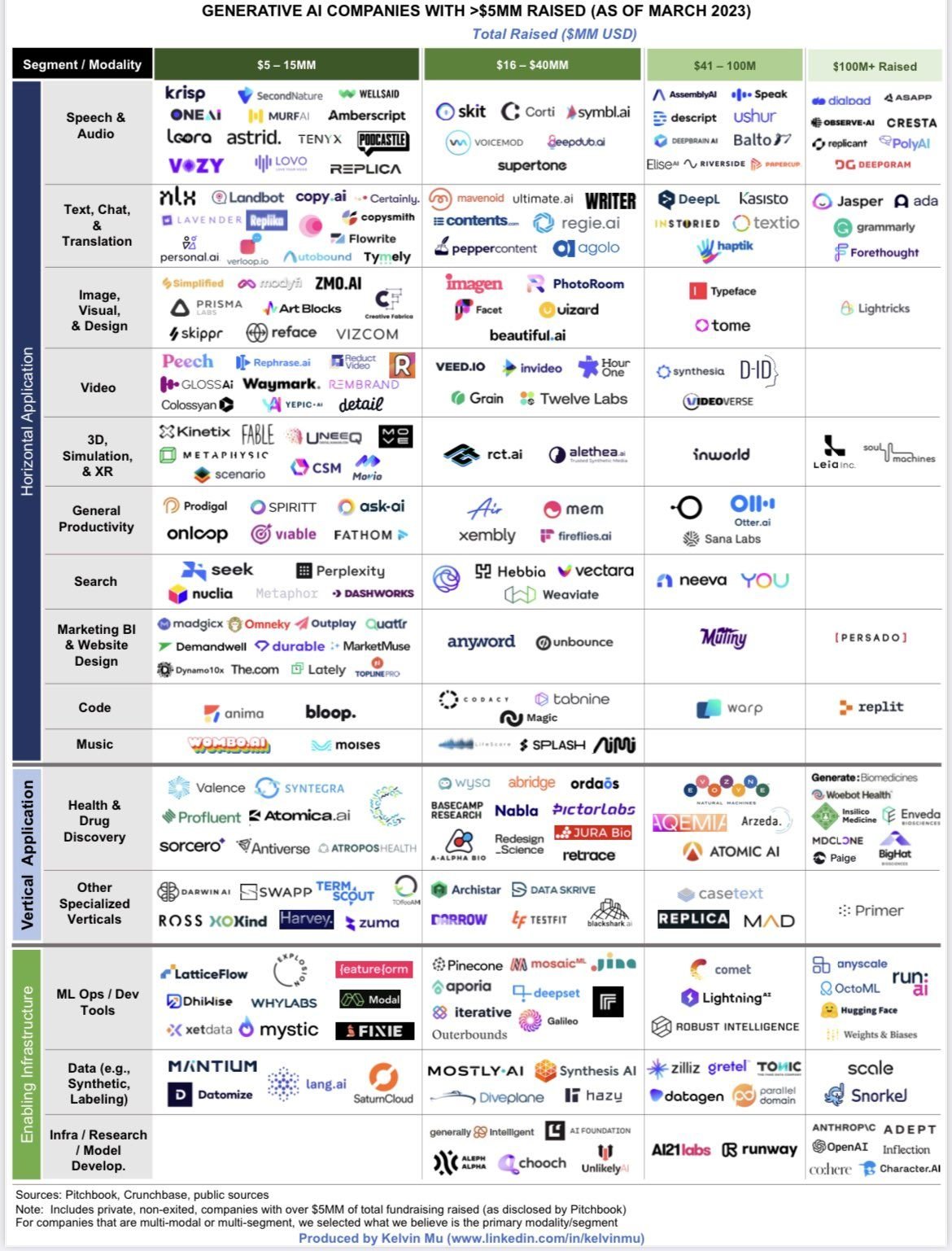This post will simply highlight the work of others. I’ll drop in a few Market Maps and visuals that I found useful in understanding the generative AI market.
(1 - The Generative AI Stack) A post from Palak Goel of Madrona Venture Partners. He seperates out the market into Models which require Data to train that then produce Evaluated outputs which are eventually Deployed via Application Frameworks to create end-user Applications. It’s a great view that helps to separate out the many players in this space.
“There is just so much happening in AI right now! Applications that used to take years to develop are now being built over weekend hackathons. It’s all a testament to the power of foundation models (we have not found the outer limits yet) and rapid innovation at the infrastructure layer to put that power in the hands of more developers. While this progress opens up exciting possibilities, it also poses challenges to developers who may find themselves overwhelmed by the myriad options available. Fortunately, as the ecosystem matures, we are beginning to see components of a new generative AI stack developing.”
(2 - Generative AI Market w/ Fundraising) A post from Peter Yang of Roblox which describes all the companies (as of March 2023) that raised venture funding. While a few months outdated, it’s an interesting view of how he split the market.
(3 - Sequoia Market Map and Manifesto) Written by Sonya Huang, Pat Grady, and GPT-3, Sequoia recently created a Generative AI Application Landscape article. Surprisingly, it was published in September 2022 before most people even knew about the term Generative AI.
Generative AI is well on the way to becoming not just faster and cheaper, but better in some cases than what humans create by hand. Every industry that requires humans to create original work—from social media to gaming, advertising to architecture, coding to graphic design, product design to law, marketing to sales—is up for reinvention. Certain functions may be completely replaced by generative AI, while others are more likely to thrive from a tight iterative creative cycle between human and machine—but generative AI should unlock better, faster and cheaper creation across a wide range of end markets. The dream is that generative AI brings the marginal cost of creation and knowledge work down towards zero, generating vast labor productivity and economic value—and commensurate market cap.
According to them, there are 4 waves:
Small Models Reign Supreme (pre-2015): Small models are considered “state of the art” for understanding language. These small models excel at analytical tasks and become deployed for jobs from delivery time prediction to fraud classification.
The Race to Scale (2015 - Today): Google Research (Attention is All You Need) describes a new neural network architecture for natural language understanding called transformers that can generate superior quality language models while being more parallelizable and requiring significantly less time to train.
Better, faster, cheaper (2022+): Compute gets cheaper. New techniques, like diffusion models, shrink down the costs required to train and run inference. The research community continues to develop better algorithms and larger models. Developer access expands from closed beta to open beta, or in some cases, open source.
Killer apps emerge (Now): With the platform layer solidifying, models continuing to get better/faster/cheaper, and model access trending to free and open source, the application layer is ripe for an explosion of creativity.
(4 - The AI 50) And finally, the AI 50! Here’s a quote from Konstatine Buhler:
When we launched the AI 50 almost five years ago, I wrote, “Although artificial general intelligence (AGI)… gets a lot of attention in film, that field is a long way off.” Today, that sci-fi future feels much closer.
The biggest change has been the rise of generative AI, and particularly the use of transformers (a type of neural network) for everything from text and image generation to protein folding and computational chemistry. Generative AI was in the background on last year’s list but in the foreground now.
Subscribe here to get access to the first 500 ideas from our blog. For just one coffee a month, you can have access to more than $500 billion dollars of ideas. What's not to love?
(5 - Market Map: Gen AI Companies with Foundational Models). “There is OpenAI’s GPT-4 and there is Google’s PaLM2, and there is also an emerging ecosystem of generative AI companies who are developing foundational models, each targeting a different part of the market with a unique set of products and value propositions. Each company is working on a specific vision for itself and its offering and aiming to capture a share of the market and push the boundaries of AI.
With over US$1.7B in funding for generative AI start-ups announced in Q1 of 2023, the landscape is at the beginning and it is very interesting to watch and analyze how it unfolds and matures. Here is a look at the largest gen AI companies developing foundational models at the beginning of June 2023.”
Contributed by: Michael Bervell (Billion Dollar Startup Ideas)






